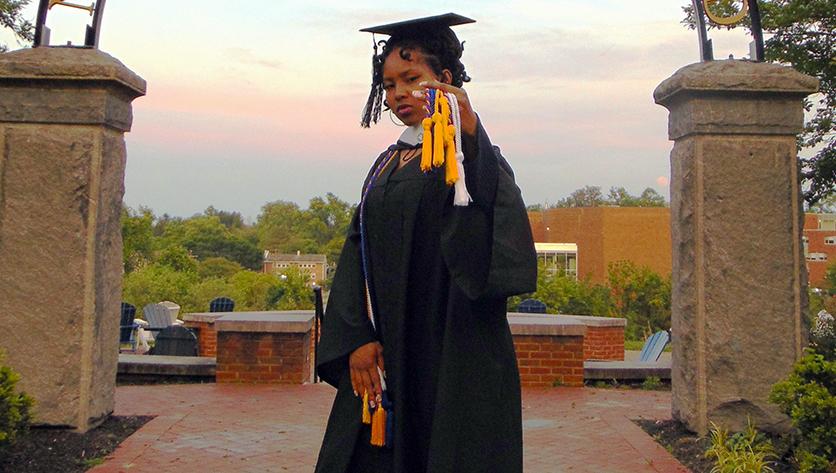Student Leader Aims to Become First Graduate of NDMU’s Accelerated Dual Degree Art Therapy Program

By: Erik Pedersen, Content Strategy Director
BALTIMORE – Aniyah Plumer ’24, M’26 reached a major milestone in her journey towards becoming the first student to complete Notre Dame of Maryland University’s Five-Year Dual Degree Art Therapy program in May, when she crossed the stage at Commencement after needing only three years to earn her bachelor’s degree in art therapy.
Plumer will now begin the Art Therapy Department’s nationally accredited master’s program this fall, as she joins the seventh cohort for Maryland’s only graduate program preparing students to become professional art therapists. A first-generation college student who earned a spot on the Dean’s List this spring, Plumer took 19 credits per semester to ensure that she would be able to earn her undergraduate degree in three years.
Despite that busy schedule, she remains one of Notre Dame’s most-engaged student leaders on campus. Plumer served as president of the Student Government Association (SGA) during the 2023-24 academic year after previous stints as Campus Activities Board (CAB) president, Residence Hall Association vice president, and sophomore class president. She was also a student representative for Notre Dame’s Diversity, Equity, and Inclusion board and the University’s Coed Task Force.
Plumer will remain involved on campus as a graduate student. She will welcome the incoming Class of 2028 to campus later this month while working as an Orientation Leader for a third-consecutive year, and she will serve as a graduate assistant for the Student Engagement office during the 2024-25 academic year.
Learn more about what led Plumer to Notre Dame, her experiences as an art therapy student, and the accomplishments she is most proud of during her various leadership roles:
What drew you to art therapy, and how did you discover the art therapy program here at Notre Dame?
I had always been involved in art in high school, and I knew I wanted to go into a field that was focused on helping people. As I learned about art therapy, it seemed like the perfect field for me to get into. I first met Professor Cathy Goucher [department chair] during a virtual Zoom session, where we were able to have a full in-depth discussion about the program.
It was a great conversation. Not every school had the ability to make students feel welcome in these virtual sessions during the pandemic, but Professor Goucher had a really positive energy on camera. She was fully engaged with me, and she gave me all the information that I needed. It attracted me to both Notre Dame and the Art Therapy Department.
Were there any classes or service opportunities that stood out for you as an undergrad?
During my freshman year, I participated in the Clothesline Project at Marian House. That experience really helped me solidify my decision to become an art therapist, even though it wasn’t directly related to art therapy. The Clothesline Project is about raising awareness for survivors of assault and abuse. It displays colored t-shirts representing different types of violence – the women at Marian House picked their shirt color and decorated them with their story, a message of encouragement, things like that.
Working with the women and experiencing the healing and benefits that can come from community art making made me realize that, yes, I want to be an art therapist. I want to do more of this. During my junior year, I also volunteered with other students at the Maryland Correctional Institute for Women in Jessup through the Prison Art Program. That was another big moment for me where I was able to get to know those women and apply everything I had learned in my classes.
Did you have an opportunity to work in a professional art therapy setting, and do you have an idea on what kind of environment you would like to work in after completing the five-year program?
I did my practicum at the Pediatric Progressive Care Unit (PPCU) at University of Maryland Medical Center. I was able to work with the head of the art therapy department there, which was founded by Yumi C.A.R.E.S., and I also assisted in the hospital’s Child Life Program as well. During graduate school, I’m going to be an intern for Roberta’s House in Baltimore, helping them to expand their art therapy program there after I complete my shadowing hours.
Once I finish the five-year program, I am hoping to work with incarcerated women, or a different population of women in need. I have been exposed to a lot of different populations at Notre Dame, but those groups have spoken to me the most.
You have held a variety of leadership positions here at Notre Dame. Had you always planned to be an active leader on campus?
I was actually not involved in anything during my freshman year outside of my work study job. I was very quiet – a lot of people didn’t even know I was here. Getting involved helped me find my voice. I learned how to advocate both for myself and for others, I learned interpersonal skills, and I learned how to manage my time – I was taking 19 credits a semester as part of the five-year program.
I’m still very shy, but my leadership positions taught me how to navigate larger groups of people and take charge effectively. They definitely added a lot of value to my Notre Dame experience.
What are some things that you’re most proud of accomplishing in your various leadership roles?
Working as an Orientation Leader is something that I’m very proud of. I’ve done it for three years – it’s great to work with the incoming students and set the tone for their NDMU experience. I still know everyone in my groups because I’ve created that safe space for them. Building a community starts right when students arrive on campus, and ensuring them that they made the right decision to come here is important to me.
For CAB, I became president while we were coming out of the pandemic, and there was a strong desire to increase the number of in-person events on campus. I’m proud that we were able to create new events that have become campus traditions. Silent Disco is a big one. We’ve been doing that every year since I started. People ask for it – it’s something that they look forward to at the beginning of the fall and spring semesters. Our talent show, where we had faculty and staff participate with students, bridging that gap, that’s another event that I’m proud of.
The reestablishment of Notre Dame’s SGA is another big one. We have a whole new constitution, and we have been able to ensure representation across all different parts of campus. I got involved with the Coed Task Force Committee because I felt like students needed to have more awareness of the decisions that are made behind the scenes. Now, as a part of our SGA constitution, the student body president sits on the general board of the Board of Trustees, and our treasurer sits on the finance board of the Board of Trustees. We’re making sure that the students are aware of and have a voice in what is taking place on campus. That is one of my biggest accomplishments.
Is there any message that you’d like to give to current NDMU students about the importance of being involved on campus?
I do believe that it is important to be involved, but in order for that to happen, you have to be open to trying something new. I had never served on any board in high school or for any other group I had been a part of. When people asked me to take charge at first, I was ready to shy away from it because that wasn’t who I thought I was. Changing that mindset, and becoming open to learning and trying something new, I think that is what set the course for me getting involved and being able to make a real impact on campus.
Established in 1895, Notre Dame of Maryland University (NDMU) is a private, Catholic institution in Baltimore, Maryland, with the mission to educate leaders to transform the world. Notre Dame has been named one of the best "Regional Universities North" by U.S. News & World Report.




